MGMT1201 Business Communication: Generational Communication Report
VerifiedAdded on 2022/09/13
|10
|1605
|11
Report
AI Summary
This report examines the impact of generational preferences on communication within the workplace, using Process Leadership as a case study. The report highlights communication challenges stemming from differing preferences among Baby Boomers, Gen X, and Millennials, emphasizing the shift from traditional methods to digital tools. The introduction outlines the communication issues caused by generational differences. The findings and analysis section presents research on communication preferences, including a study on mobile phone usage. The study reveals Millennials' preference for texting and its impact on communication efficacy, while Baby Boomers show a preference for face-to-face communication. The report recommends using multiple communication methods to accommodate different generational preferences and improve workplace collaboration and efficiency. It suggests a blend of online and in-person approaches, including email, text messages, and meetings. The report concludes by emphasizing the importance of customizing communication methods to suit each employee's needs, fostering better coordination and motivation within the workforce. The report is a final assignment for a Business Communication course, analyzing communication challenges and opportunities in today's businesses.
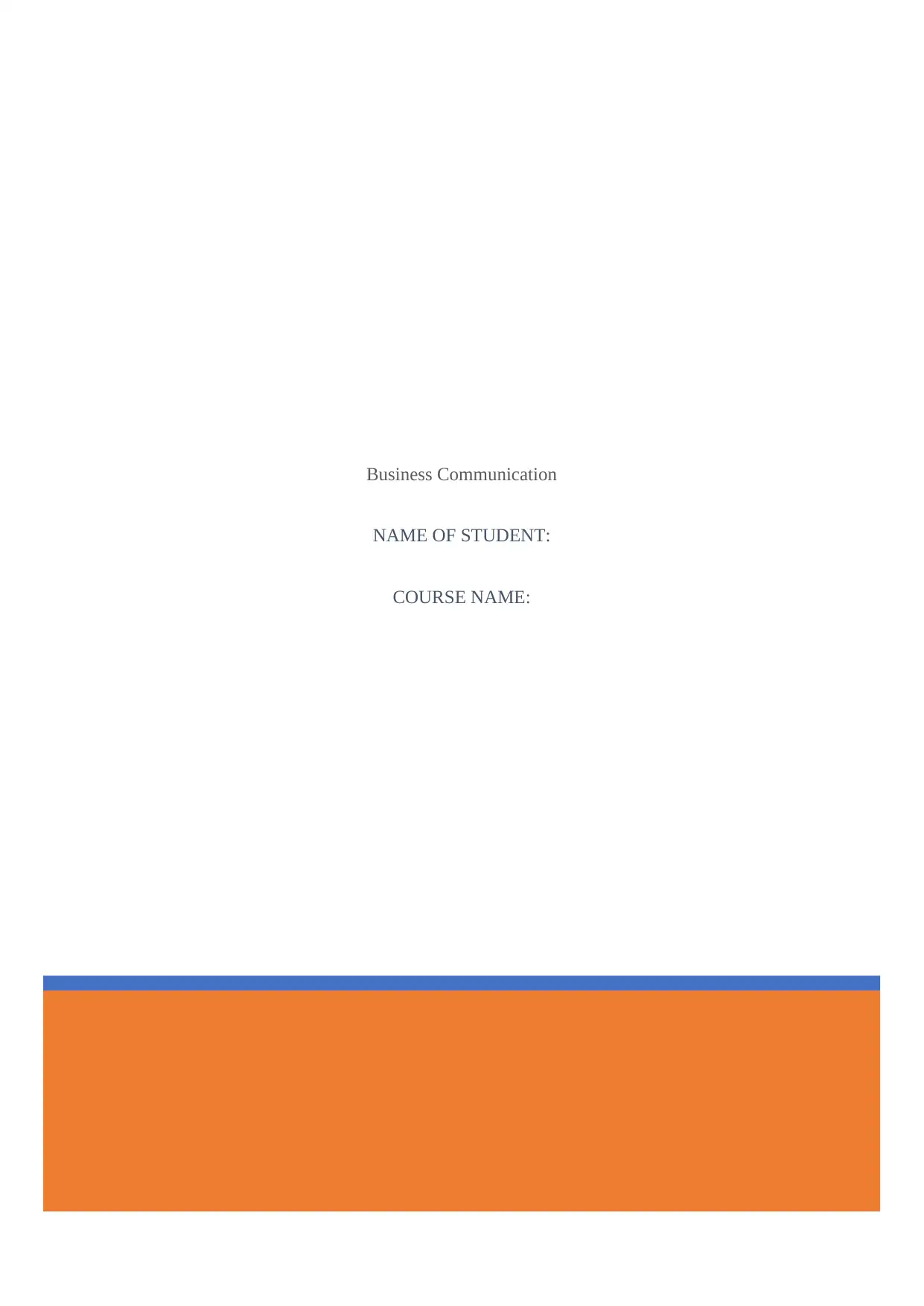
Business Communication
NAME OF STUDENT:
COURSE NAME:
NAME OF STUDENT:
COURSE NAME:
Paraphrase This Document
Need a fresh take? Get an instant paraphrase of this document with our AI Paraphraser
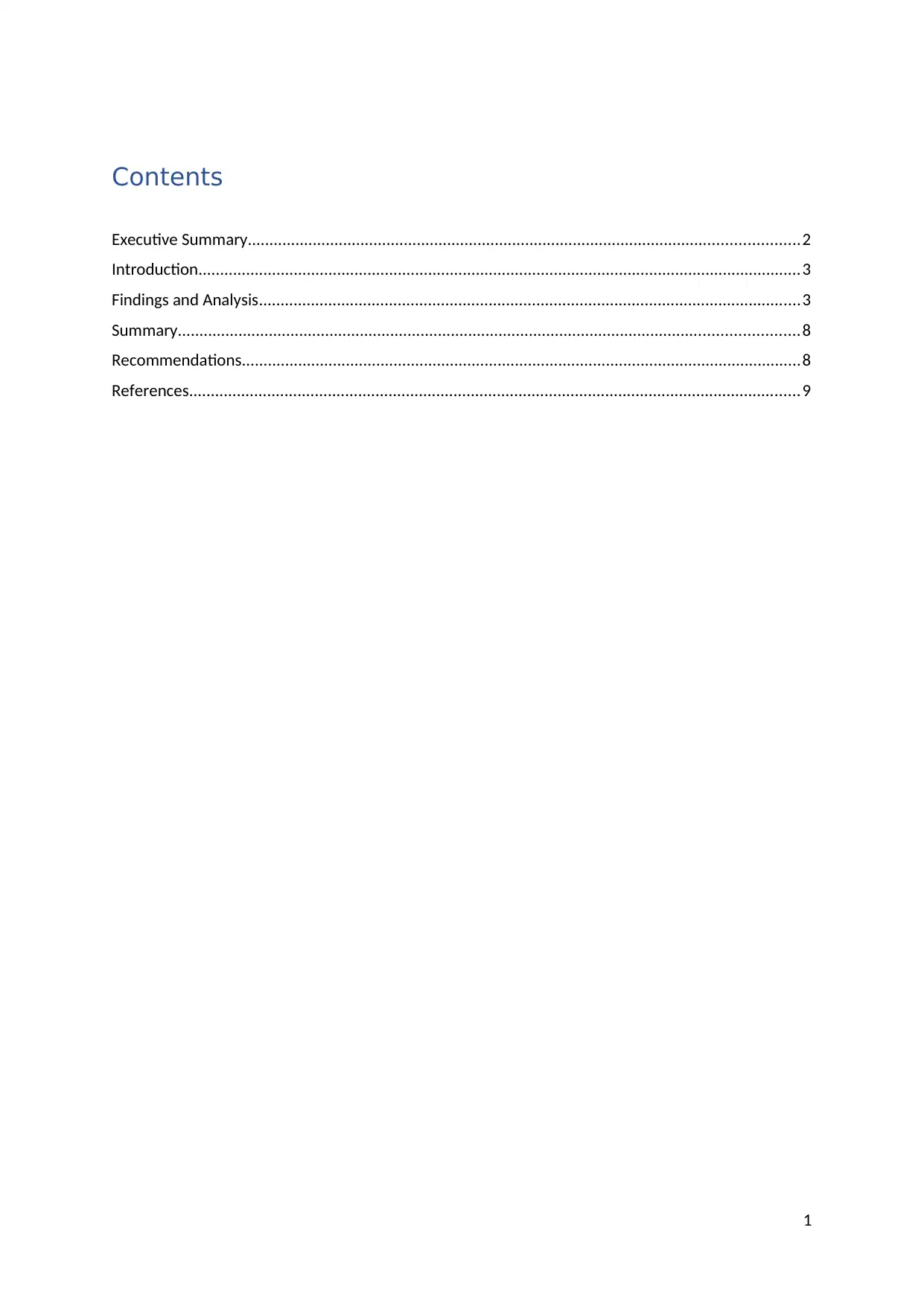
Contents
Executive Summary...............................................................................................................................2
Introduction...........................................................................................................................................3
Findings and Analysis.............................................................................................................................3
Summary...............................................................................................................................................8
Recommendations.................................................................................................................................8
References.............................................................................................................................................9
1
Executive Summary...............................................................................................................................2
Introduction...........................................................................................................................................3
Findings and Analysis.............................................................................................................................3
Summary...............................................................................................................................................8
Recommendations.................................................................................................................................8
References.............................................................................................................................................9
1
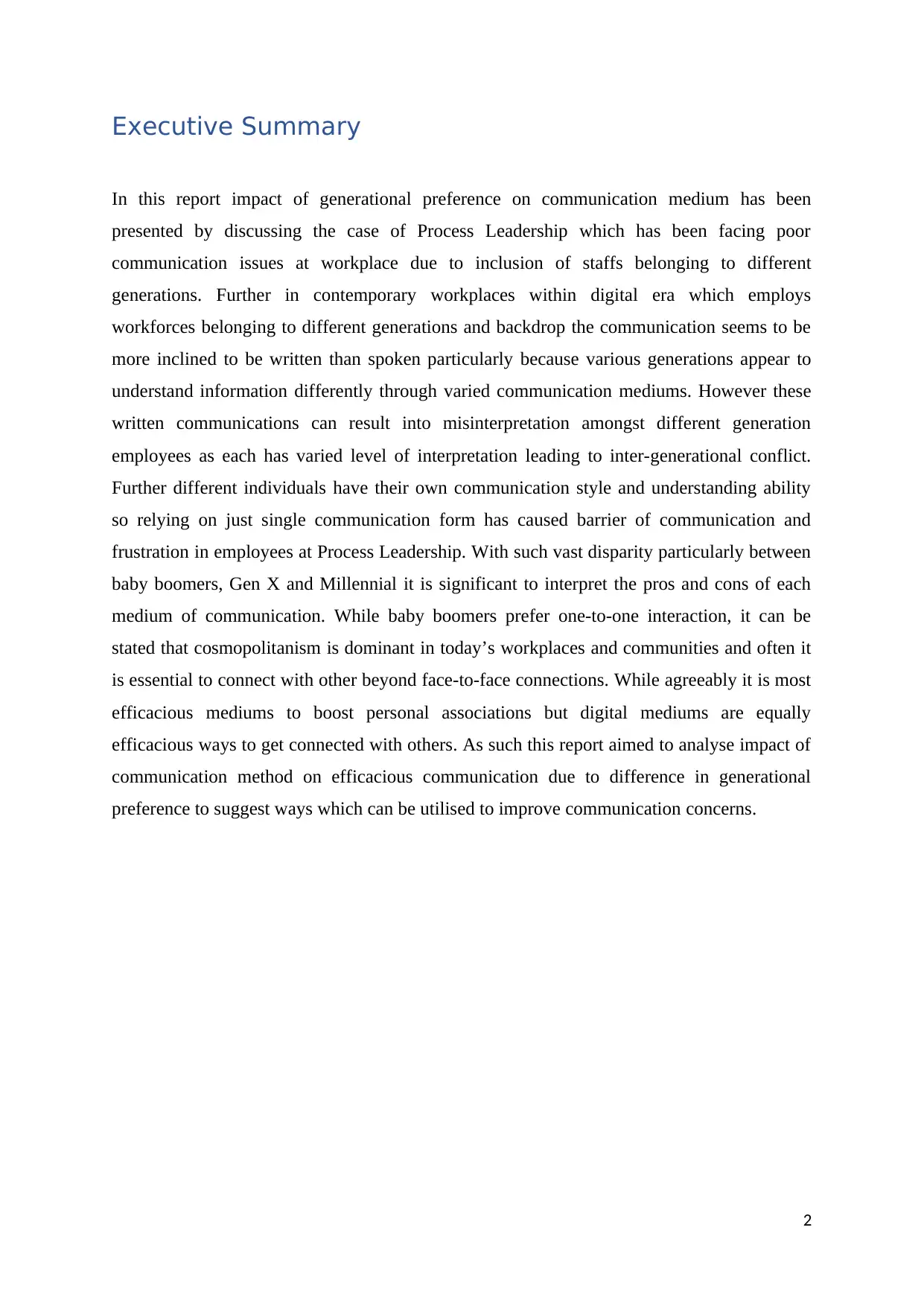
Executive Summary
In this report impact of generational preference on communication medium has been
presented by discussing the case of Process Leadership which has been facing poor
communication issues at workplace due to inclusion of staffs belonging to different
generations. Further in contemporary workplaces within digital era which employs
workforces belonging to different generations and backdrop the communication seems to be
more inclined to be written than spoken particularly because various generations appear to
understand information differently through varied communication mediums. However these
written communications can result into misinterpretation amongst different generation
employees as each has varied level of interpretation leading to inter-generational conflict.
Further different individuals have their own communication style and understanding ability
so relying on just single communication form has caused barrier of communication and
frustration in employees at Process Leadership. With such vast disparity particularly between
baby boomers, Gen X and Millennial it is significant to interpret the pros and cons of each
medium of communication. While baby boomers prefer one-to-one interaction, it can be
stated that cosmopolitanism is dominant in today’s workplaces and communities and often it
is essential to connect with other beyond face-to-face connections. While agreeably it is most
efficacious mediums to boost personal associations but digital mediums are equally
efficacious ways to get connected with others. As such this report aimed to analyse impact of
communication method on efficacious communication due to difference in generational
preference to suggest ways which can be utilised to improve communication concerns.
2
In this report impact of generational preference on communication medium has been
presented by discussing the case of Process Leadership which has been facing poor
communication issues at workplace due to inclusion of staffs belonging to different
generations. Further in contemporary workplaces within digital era which employs
workforces belonging to different generations and backdrop the communication seems to be
more inclined to be written than spoken particularly because various generations appear to
understand information differently through varied communication mediums. However these
written communications can result into misinterpretation amongst different generation
employees as each has varied level of interpretation leading to inter-generational conflict.
Further different individuals have their own communication style and understanding ability
so relying on just single communication form has caused barrier of communication and
frustration in employees at Process Leadership. With such vast disparity particularly between
baby boomers, Gen X and Millennial it is significant to interpret the pros and cons of each
medium of communication. While baby boomers prefer one-to-one interaction, it can be
stated that cosmopolitanism is dominant in today’s workplaces and communities and often it
is essential to connect with other beyond face-to-face connections. While agreeably it is most
efficacious mediums to boost personal associations but digital mediums are equally
efficacious ways to get connected with others. As such this report aimed to analyse impact of
communication method on efficacious communication due to difference in generational
preference to suggest ways which can be utilised to improve communication concerns.
2
⊘ This is a preview!⊘
Do you want full access?
Subscribe today to unlock all pages.

Trusted by 1+ million students worldwide
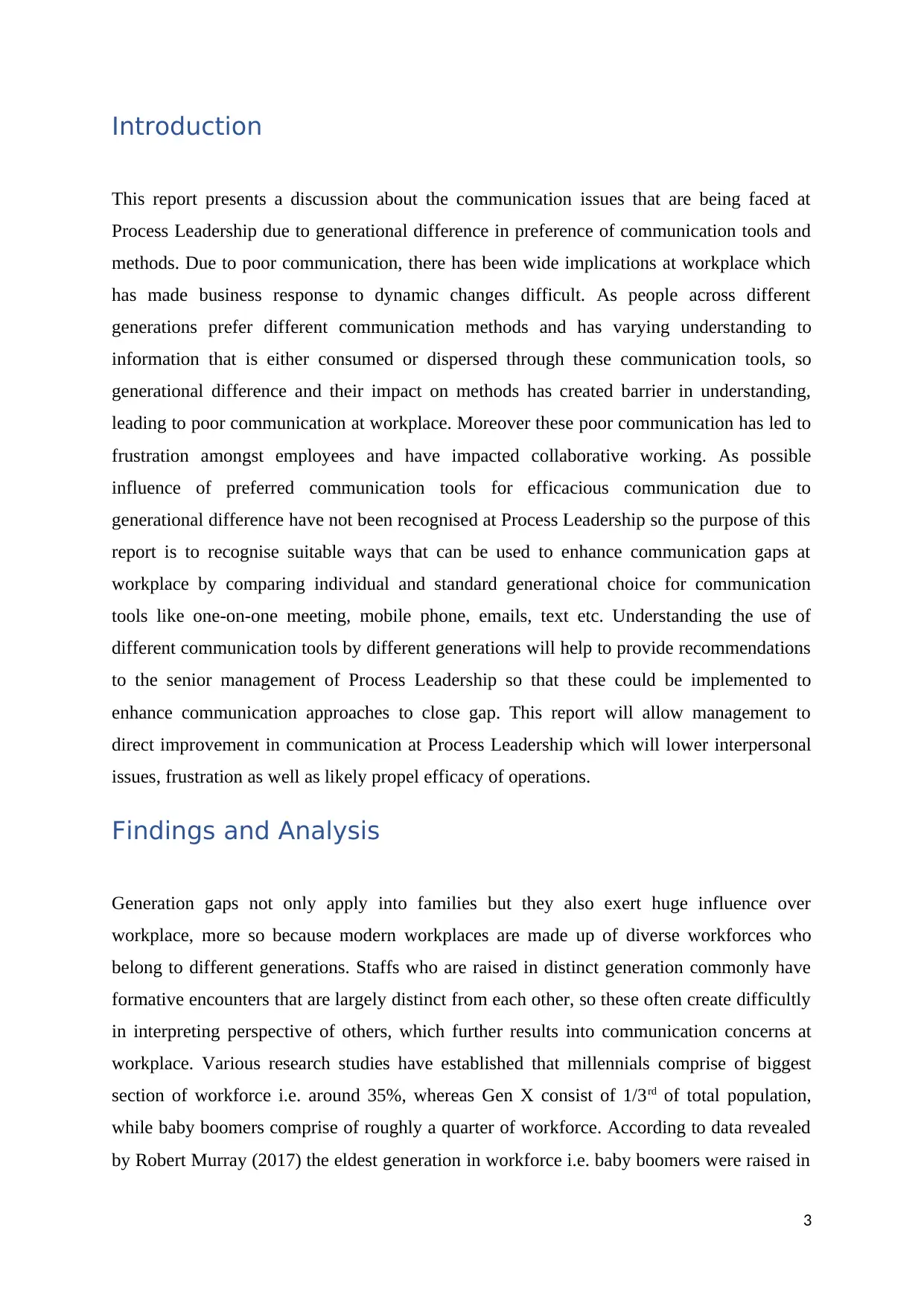
Introduction
This report presents a discussion about the communication issues that are being faced at
Process Leadership due to generational difference in preference of communication tools and
methods. Due to poor communication, there has been wide implications at workplace which
has made business response to dynamic changes difficult. As people across different
generations prefer different communication methods and has varying understanding to
information that is either consumed or dispersed through these communication tools, so
generational difference and their impact on methods has created barrier in understanding,
leading to poor communication at workplace. Moreover these poor communication has led to
frustration amongst employees and have impacted collaborative working. As possible
influence of preferred communication tools for efficacious communication due to
generational difference have not been recognised at Process Leadership so the purpose of this
report is to recognise suitable ways that can be used to enhance communication gaps at
workplace by comparing individual and standard generational choice for communication
tools like one-on-one meeting, mobile phone, emails, text etc. Understanding the use of
different communication tools by different generations will help to provide recommendations
to the senior management of Process Leadership so that these could be implemented to
enhance communication approaches to close gap. This report will allow management to
direct improvement in communication at Process Leadership which will lower interpersonal
issues, frustration as well as likely propel efficacy of operations.
Findings and Analysis
Generation gaps not only apply into families but they also exert huge influence over
workplace, more so because modern workplaces are made up of diverse workforces who
belong to different generations. Staffs who are raised in distinct generation commonly have
formative encounters that are largely distinct from each other, so these often create difficultly
in interpreting perspective of others, which further results into communication concerns at
workplace. Various research studies have established that millennials comprise of biggest
section of workforce i.e. around 35%, whereas Gen X consist of 1/3rd of total population,
while baby boomers comprise of roughly a quarter of workforce. According to data revealed
by Robert Murray (2017) the eldest generation in workforce i.e. baby boomers were raised in
3
This report presents a discussion about the communication issues that are being faced at
Process Leadership due to generational difference in preference of communication tools and
methods. Due to poor communication, there has been wide implications at workplace which
has made business response to dynamic changes difficult. As people across different
generations prefer different communication methods and has varying understanding to
information that is either consumed or dispersed through these communication tools, so
generational difference and their impact on methods has created barrier in understanding,
leading to poor communication at workplace. Moreover these poor communication has led to
frustration amongst employees and have impacted collaborative working. As possible
influence of preferred communication tools for efficacious communication due to
generational difference have not been recognised at Process Leadership so the purpose of this
report is to recognise suitable ways that can be used to enhance communication gaps at
workplace by comparing individual and standard generational choice for communication
tools like one-on-one meeting, mobile phone, emails, text etc. Understanding the use of
different communication tools by different generations will help to provide recommendations
to the senior management of Process Leadership so that these could be implemented to
enhance communication approaches to close gap. This report will allow management to
direct improvement in communication at Process Leadership which will lower interpersonal
issues, frustration as well as likely propel efficacy of operations.
Findings and Analysis
Generation gaps not only apply into families but they also exert huge influence over
workplace, more so because modern workplaces are made up of diverse workforces who
belong to different generations. Staffs who are raised in distinct generation commonly have
formative encounters that are largely distinct from each other, so these often create difficultly
in interpreting perspective of others, which further results into communication concerns at
workplace. Various research studies have established that millennials comprise of biggest
section of workforce i.e. around 35%, whereas Gen X consist of 1/3rd of total population,
while baby boomers comprise of roughly a quarter of workforce. According to data revealed
by Robert Murray (2017) the eldest generation in workforce i.e. baby boomers were raised in
3
Paraphrase This Document
Need a fresh take? Get an instant paraphrase of this document with our AI Paraphraser
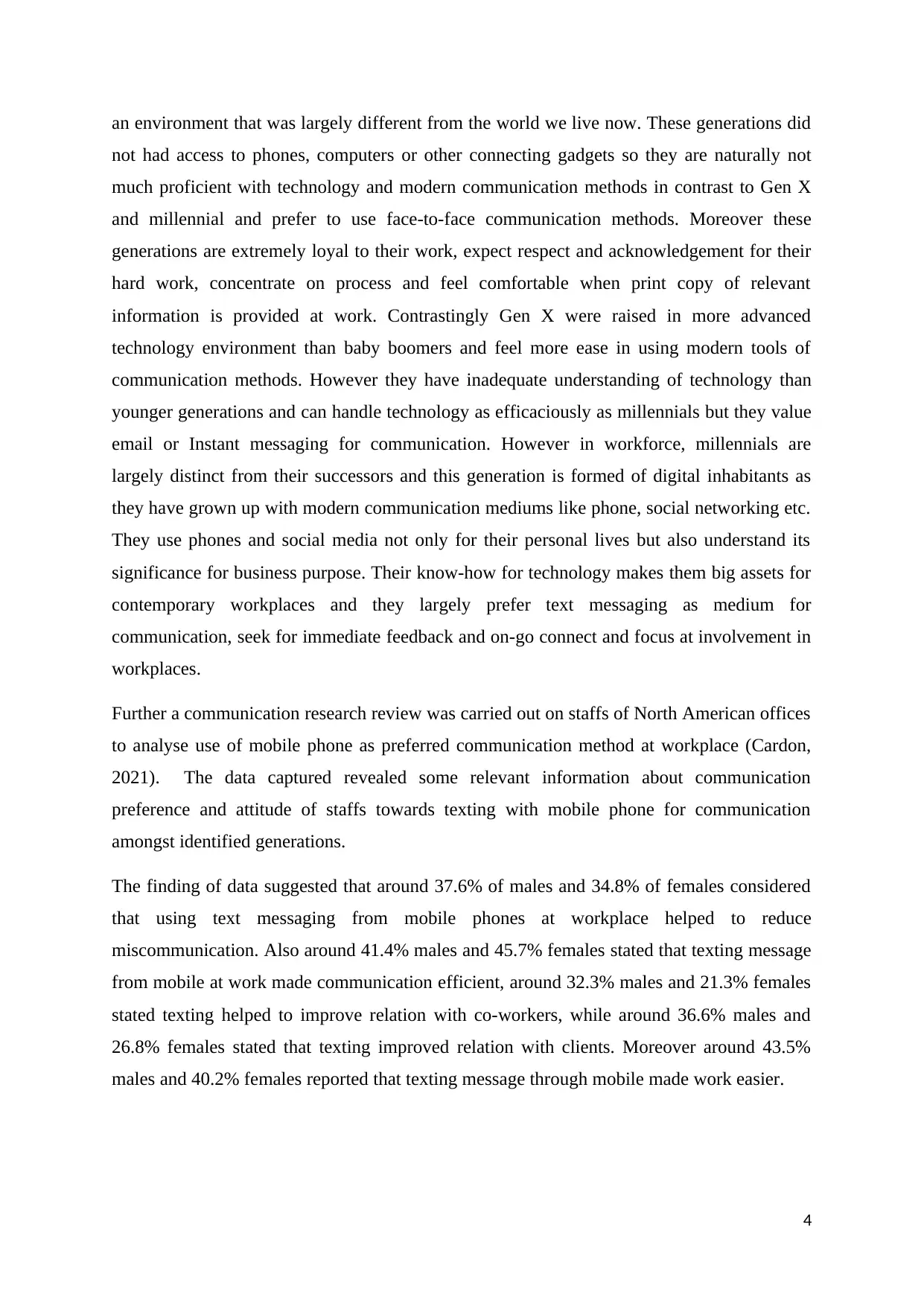
an environment that was largely different from the world we live now. These generations did
not had access to phones, computers or other connecting gadgets so they are naturally not
much proficient with technology and modern communication methods in contrast to Gen X
and millennial and prefer to use face-to-face communication methods. Moreover these
generations are extremely loyal to their work, expect respect and acknowledgement for their
hard work, concentrate on process and feel comfortable when print copy of relevant
information is provided at work. Contrastingly Gen X were raised in more advanced
technology environment than baby boomers and feel more ease in using modern tools of
communication methods. However they have inadequate understanding of technology than
younger generations and can handle technology as efficaciously as millennials but they value
email or Instant messaging for communication. However in workforce, millennials are
largely distinct from their successors and this generation is formed of digital inhabitants as
they have grown up with modern communication mediums like phone, social networking etc.
They use phones and social media not only for their personal lives but also understand its
significance for business purpose. Their know-how for technology makes them big assets for
contemporary workplaces and they largely prefer text messaging as medium for
communication, seek for immediate feedback and on-go connect and focus at involvement in
workplaces.
Further a communication research review was carried out on staffs of North American offices
to analyse use of mobile phone as preferred communication method at workplace (Cardon,
2021). The data captured revealed some relevant information about communication
preference and attitude of staffs towards texting with mobile phone for communication
amongst identified generations.
The finding of data suggested that around 37.6% of males and 34.8% of females considered
that using text messaging from mobile phones at workplace helped to reduce
miscommunication. Also around 41.4% males and 45.7% females stated that texting message
from mobile at work made communication efficient, around 32.3% males and 21.3% females
stated texting helped to improve relation with co-workers, while around 36.6% males and
26.8% females stated that texting improved relation with clients. Moreover around 43.5%
males and 40.2% females reported that texting message through mobile made work easier.
4
not had access to phones, computers or other connecting gadgets so they are naturally not
much proficient with technology and modern communication methods in contrast to Gen X
and millennial and prefer to use face-to-face communication methods. Moreover these
generations are extremely loyal to their work, expect respect and acknowledgement for their
hard work, concentrate on process and feel comfortable when print copy of relevant
information is provided at work. Contrastingly Gen X were raised in more advanced
technology environment than baby boomers and feel more ease in using modern tools of
communication methods. However they have inadequate understanding of technology than
younger generations and can handle technology as efficaciously as millennials but they value
email or Instant messaging for communication. However in workforce, millennials are
largely distinct from their successors and this generation is formed of digital inhabitants as
they have grown up with modern communication mediums like phone, social networking etc.
They use phones and social media not only for their personal lives but also understand its
significance for business purpose. Their know-how for technology makes them big assets for
contemporary workplaces and they largely prefer text messaging as medium for
communication, seek for immediate feedback and on-go connect and focus at involvement in
workplaces.
Further a communication research review was carried out on staffs of North American offices
to analyse use of mobile phone as preferred communication method at workplace (Cardon,
2021). The data captured revealed some relevant information about communication
preference and attitude of staffs towards texting with mobile phone for communication
amongst identified generations.
The finding of data suggested that around 37.6% of males and 34.8% of females considered
that using text messaging from mobile phones at workplace helped to reduce
miscommunication. Also around 41.4% males and 45.7% females stated that texting message
from mobile at work made communication efficient, around 32.3% males and 21.3% females
stated texting helped to improve relation with co-workers, while around 36.6% males and
26.8% females stated that texting improved relation with clients. Moreover around 43.5%
males and 40.2% females reported that texting message through mobile made work easier.
4
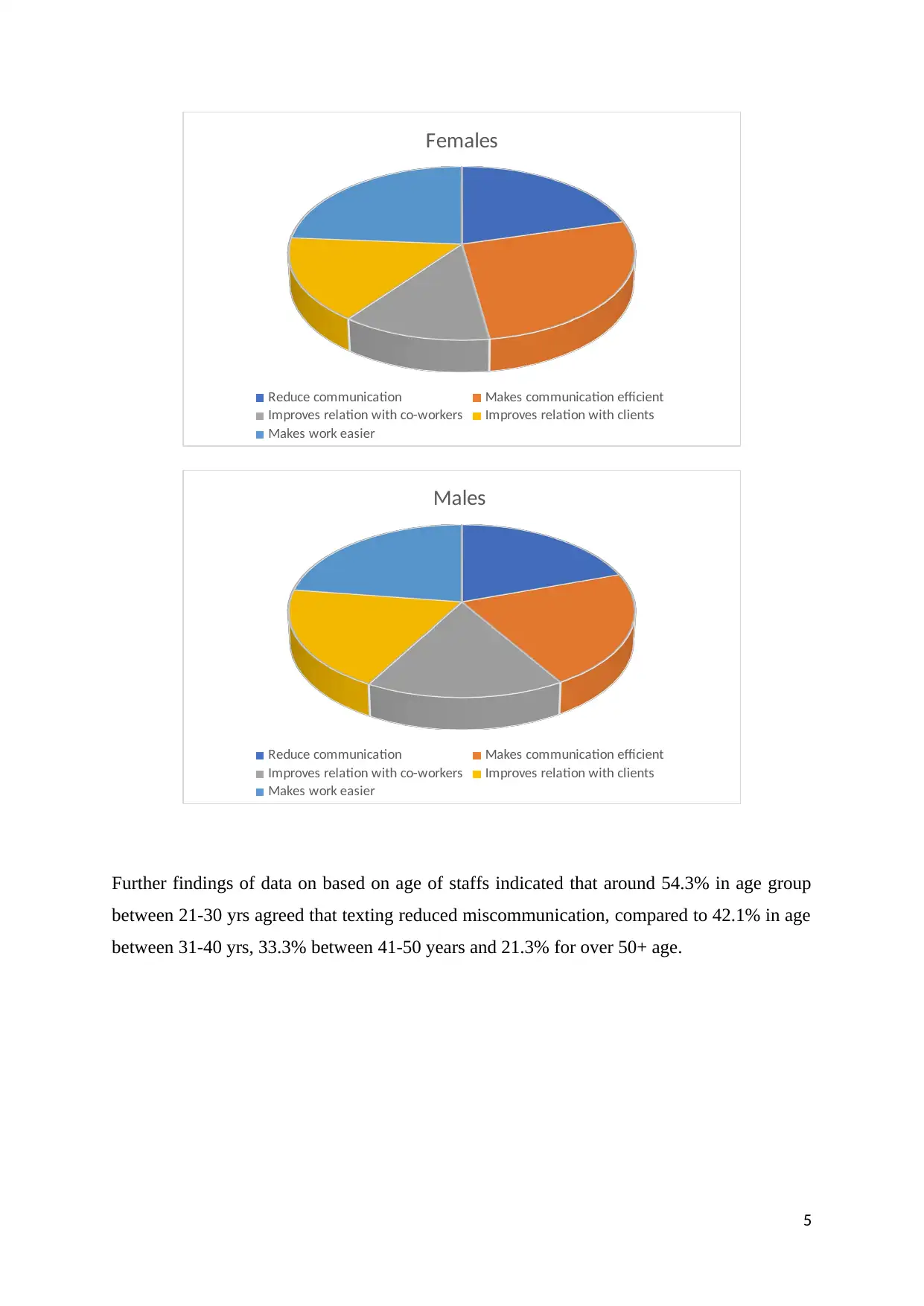
Females
Reduce communication Makes communication efficient
Improves relation with co-workers Improves relation with clients
Makes work easier
Males
Reduce communication Makes communication efficient
Improves relation with co-workers Improves relation with clients
Makes work easier
Further findings of data on based on age of staffs indicated that around 54.3% in age group
between 21-30 yrs agreed that texting reduced miscommunication, compared to 42.1% in age
between 31-40 yrs, 33.3% between 41-50 years and 21.3% for over 50+ age.
5
Reduce communication Makes communication efficient
Improves relation with co-workers Improves relation with clients
Makes work easier
Males
Reduce communication Makes communication efficient
Improves relation with co-workers Improves relation with clients
Makes work easier
Further findings of data on based on age of staffs indicated that around 54.3% in age group
between 21-30 yrs agreed that texting reduced miscommunication, compared to 42.1% in age
between 31-40 yrs, 33.3% between 41-50 years and 21.3% for over 50+ age.
5
⊘ This is a preview!⊘
Do you want full access?
Subscribe today to unlock all pages.

Trusted by 1+ million students worldwide
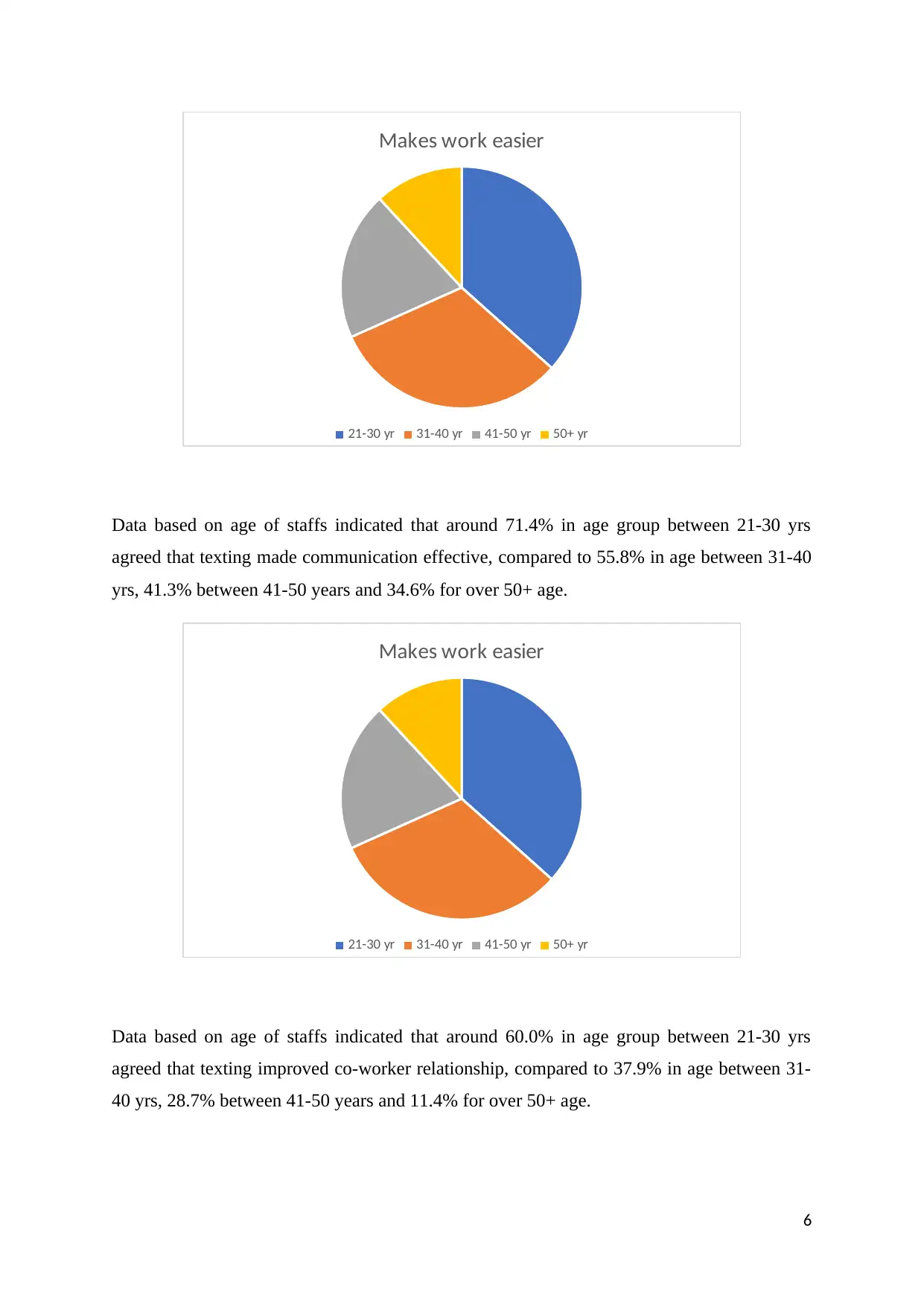
Makes work easier
21-30 yr 31-40 yr 41-50 yr 50+ yr
Data based on age of staffs indicated that around 71.4% in age group between 21-30 yrs
agreed that texting made communication effective, compared to 55.8% in age between 31-40
yrs, 41.3% between 41-50 years and 34.6% for over 50+ age.
Makes work easier
21-30 yr 31-40 yr 41-50 yr 50+ yr
Data based on age of staffs indicated that around 60.0% in age group between 21-30 yrs
agreed that texting improved co-worker relationship, compared to 37.9% in age between 31-
40 yrs, 28.7% between 41-50 years and 11.4% for over 50+ age.
6
21-30 yr 31-40 yr 41-50 yr 50+ yr
Data based on age of staffs indicated that around 71.4% in age group between 21-30 yrs
agreed that texting made communication effective, compared to 55.8% in age between 31-40
yrs, 41.3% between 41-50 years and 34.6% for over 50+ age.
Makes work easier
21-30 yr 31-40 yr 41-50 yr 50+ yr
Data based on age of staffs indicated that around 60.0% in age group between 21-30 yrs
agreed that texting improved co-worker relationship, compared to 37.9% in age between 31-
40 yrs, 28.7% between 41-50 years and 11.4% for over 50+ age.
6
Paraphrase This Document
Need a fresh take? Get an instant paraphrase of this document with our AI Paraphraser
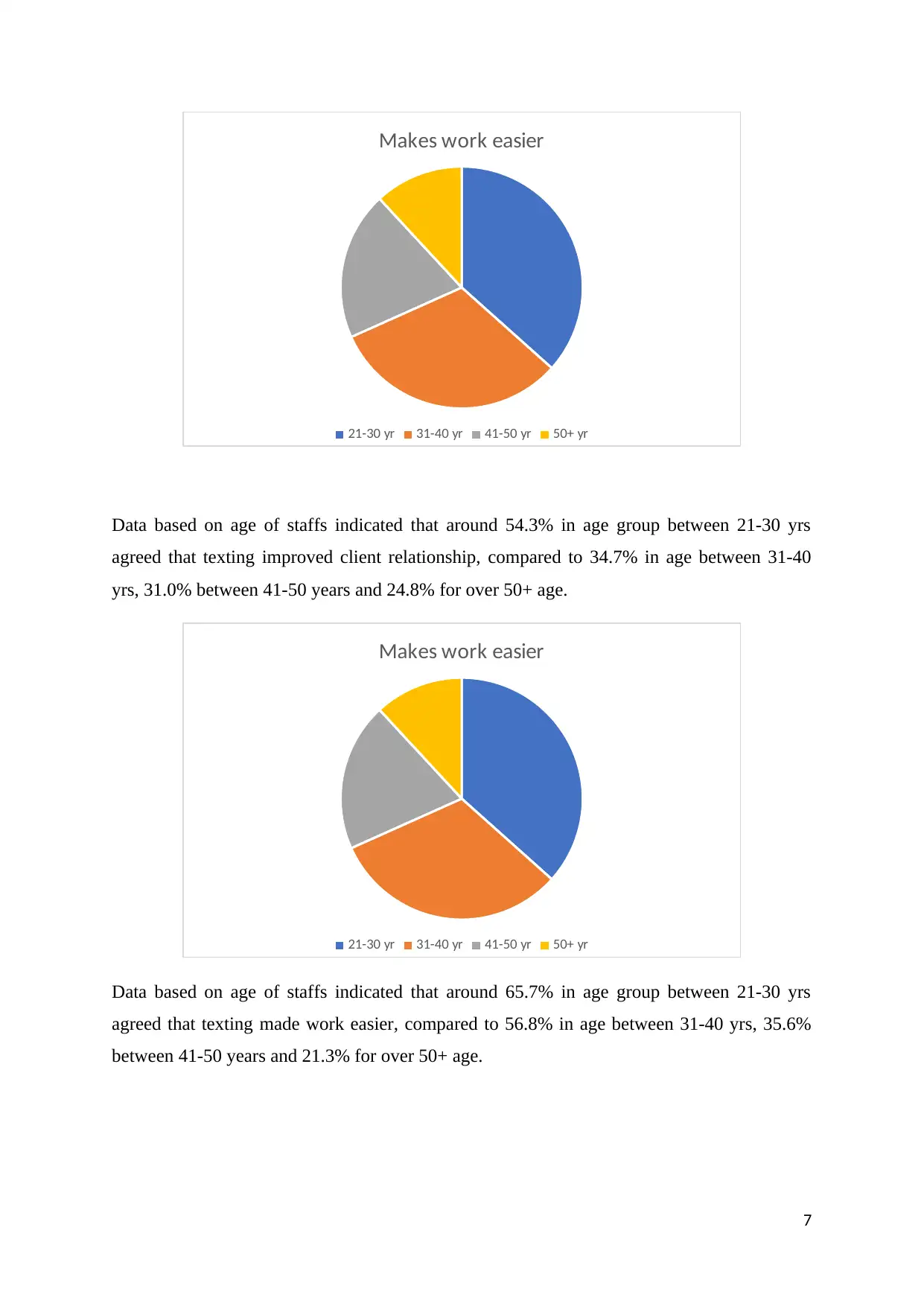
Makes work easier
21-30 yr 31-40 yr 41-50 yr 50+ yr
Data based on age of staffs indicated that around 54.3% in age group between 21-30 yrs
agreed that texting improved client relationship, compared to 34.7% in age between 31-40
yrs, 31.0% between 41-50 years and 24.8% for over 50+ age.
Makes work easier
21-30 yr 31-40 yr 41-50 yr 50+ yr
Data based on age of staffs indicated that around 65.7% in age group between 21-30 yrs
agreed that texting made work easier, compared to 56.8% in age between 31-40 yrs, 35.6%
between 41-50 years and 21.3% for over 50+ age.
7
21-30 yr 31-40 yr 41-50 yr 50+ yr
Data based on age of staffs indicated that around 54.3% in age group between 21-30 yrs
agreed that texting improved client relationship, compared to 34.7% in age between 31-40
yrs, 31.0% between 41-50 years and 24.8% for over 50+ age.
Makes work easier
21-30 yr 31-40 yr 41-50 yr 50+ yr
Data based on age of staffs indicated that around 65.7% in age group between 21-30 yrs
agreed that texting made work easier, compared to 56.8% in age between 31-40 yrs, 35.6%
between 41-50 years and 21.3% for over 50+ age.
7
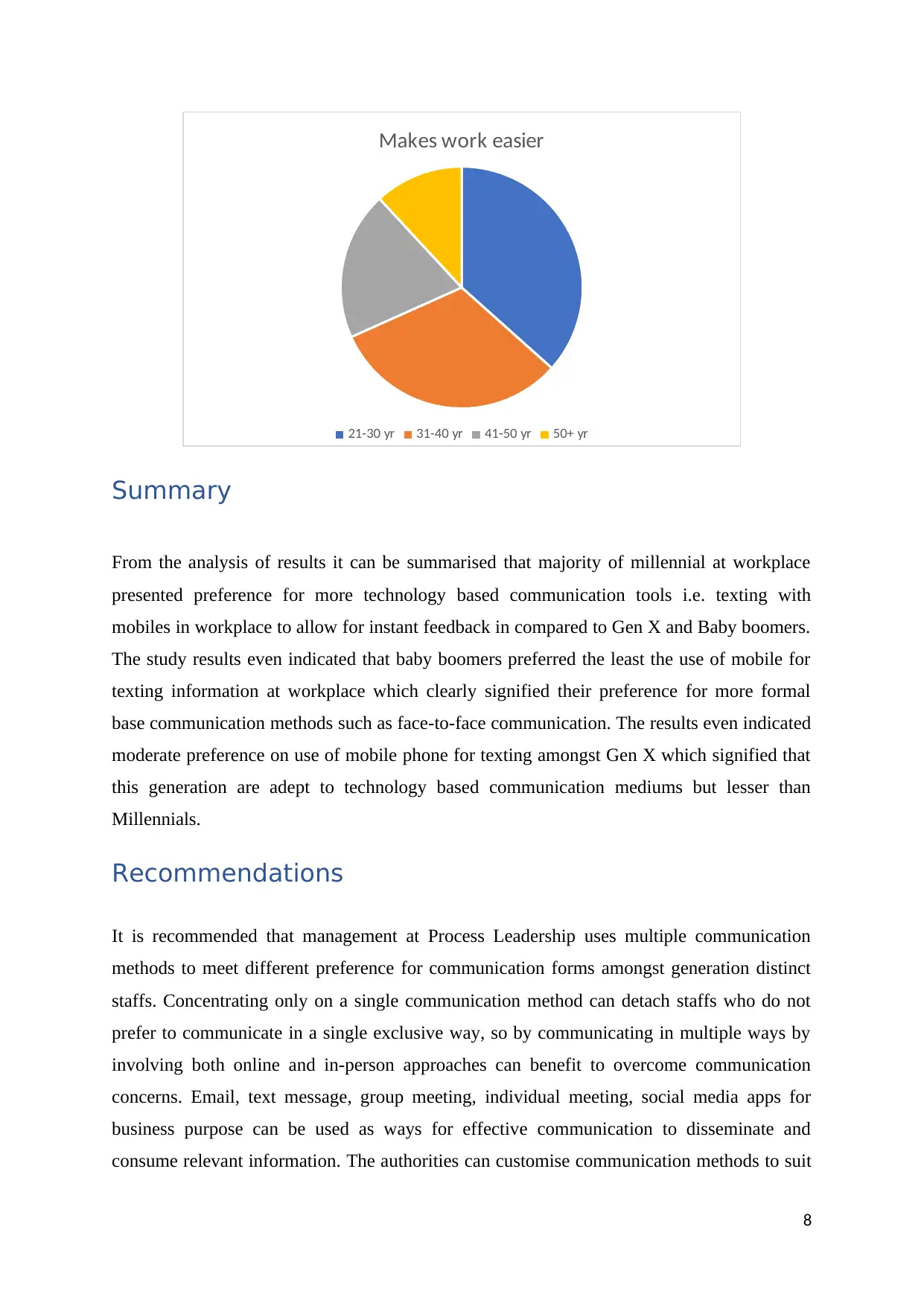
Makes work easier
21-30 yr 31-40 yr 41-50 yr 50+ yr
Summary
From the analysis of results it can be summarised that majority of millennial at workplace
presented preference for more technology based communication tools i.e. texting with
mobiles in workplace to allow for instant feedback in compared to Gen X and Baby boomers.
The study results even indicated that baby boomers preferred the least the use of mobile for
texting information at workplace which clearly signified their preference for more formal
base communication methods such as face-to-face communication. The results even indicated
moderate preference on use of mobile phone for texting amongst Gen X which signified that
this generation are adept to technology based communication mediums but lesser than
Millennials.
Recommendations
It is recommended that management at Process Leadership uses multiple communication
methods to meet different preference for communication forms amongst generation distinct
staffs. Concentrating only on a single communication method can detach staffs who do not
prefer to communicate in a single exclusive way, so by communicating in multiple ways by
involving both online and in-person approaches can benefit to overcome communication
concerns. Email, text message, group meeting, individual meeting, social media apps for
business purpose can be used as ways for effective communication to disseminate and
consume relevant information. The authorities can customise communication methods to suit
8
21-30 yr 31-40 yr 41-50 yr 50+ yr
Summary
From the analysis of results it can be summarised that majority of millennial at workplace
presented preference for more technology based communication tools i.e. texting with
mobiles in workplace to allow for instant feedback in compared to Gen X and Baby boomers.
The study results even indicated that baby boomers preferred the least the use of mobile for
texting information at workplace which clearly signified their preference for more formal
base communication methods such as face-to-face communication. The results even indicated
moderate preference on use of mobile phone for texting amongst Gen X which signified that
this generation are adept to technology based communication mediums but lesser than
Millennials.
Recommendations
It is recommended that management at Process Leadership uses multiple communication
methods to meet different preference for communication forms amongst generation distinct
staffs. Concentrating only on a single communication method can detach staffs who do not
prefer to communicate in a single exclusive way, so by communicating in multiple ways by
involving both online and in-person approaches can benefit to overcome communication
concerns. Email, text message, group meeting, individual meeting, social media apps for
business purpose can be used as ways for effective communication to disseminate and
consume relevant information. The authorities can customise communication methods to suit
8
⊘ This is a preview!⊘
Do you want full access?
Subscribe today to unlock all pages.

Trusted by 1+ million students worldwide
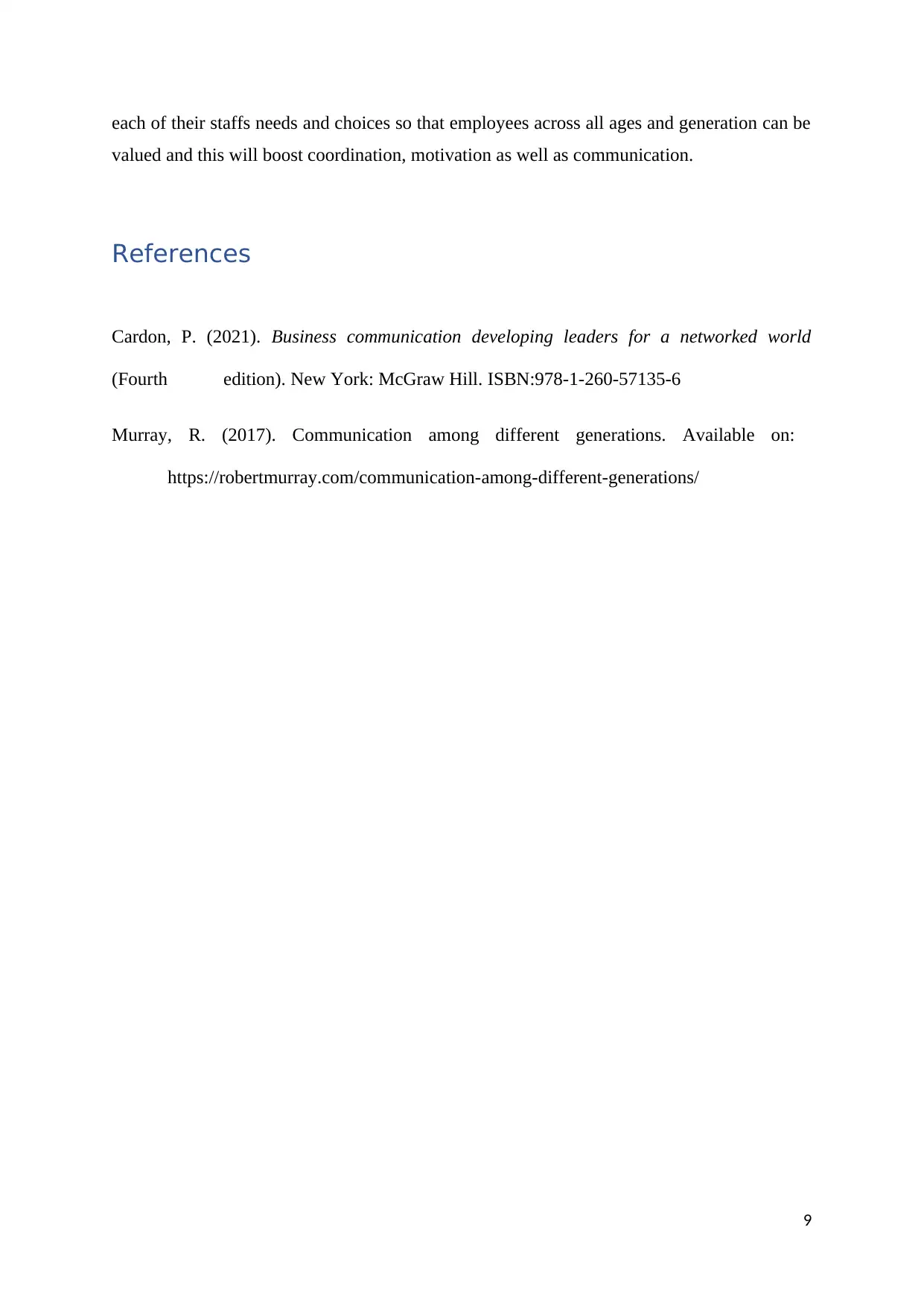
each of their staffs needs and choices so that employees across all ages and generation can be
valued and this will boost coordination, motivation as well as communication.
References
Cardon, P. (2021). Business communication developing leaders for a networked world
(Fourth edition). New York: McGraw Hill. ISBN:978-1-260-57135-6
Murray, R. (2017). Communication among different generations. Available on:
https://robertmurray.com/communication-among-different-generations/
9
valued and this will boost coordination, motivation as well as communication.
References
Cardon, P. (2021). Business communication developing leaders for a networked world
(Fourth edition). New York: McGraw Hill. ISBN:978-1-260-57135-6
Murray, R. (2017). Communication among different generations. Available on:
https://robertmurray.com/communication-among-different-generations/
9
1 out of 10
Related Documents
Your All-in-One AI-Powered Toolkit for Academic Success.
+13062052269
info@desklib.com
Available 24*7 on WhatsApp / Email
![[object Object]](/_next/static/media/star-bottom.7253800d.svg)
Unlock your academic potential
Copyright © 2020–2025 A2Z Services. All Rights Reserved. Developed and managed by ZUCOL.





